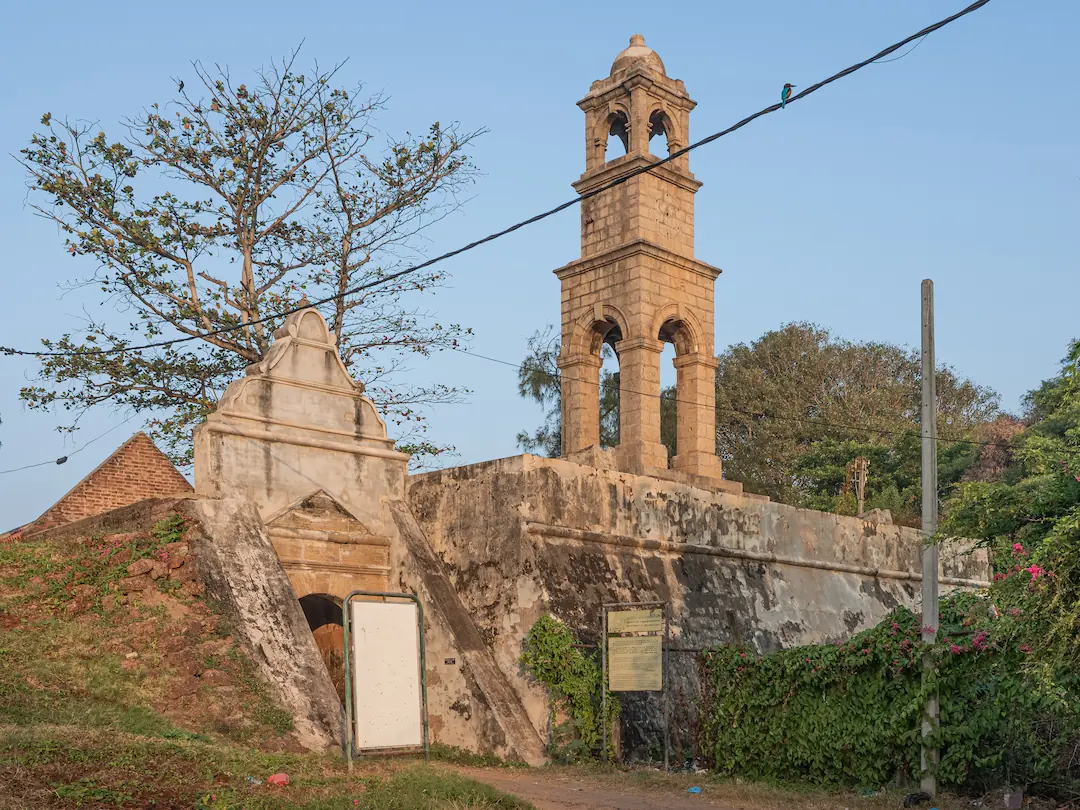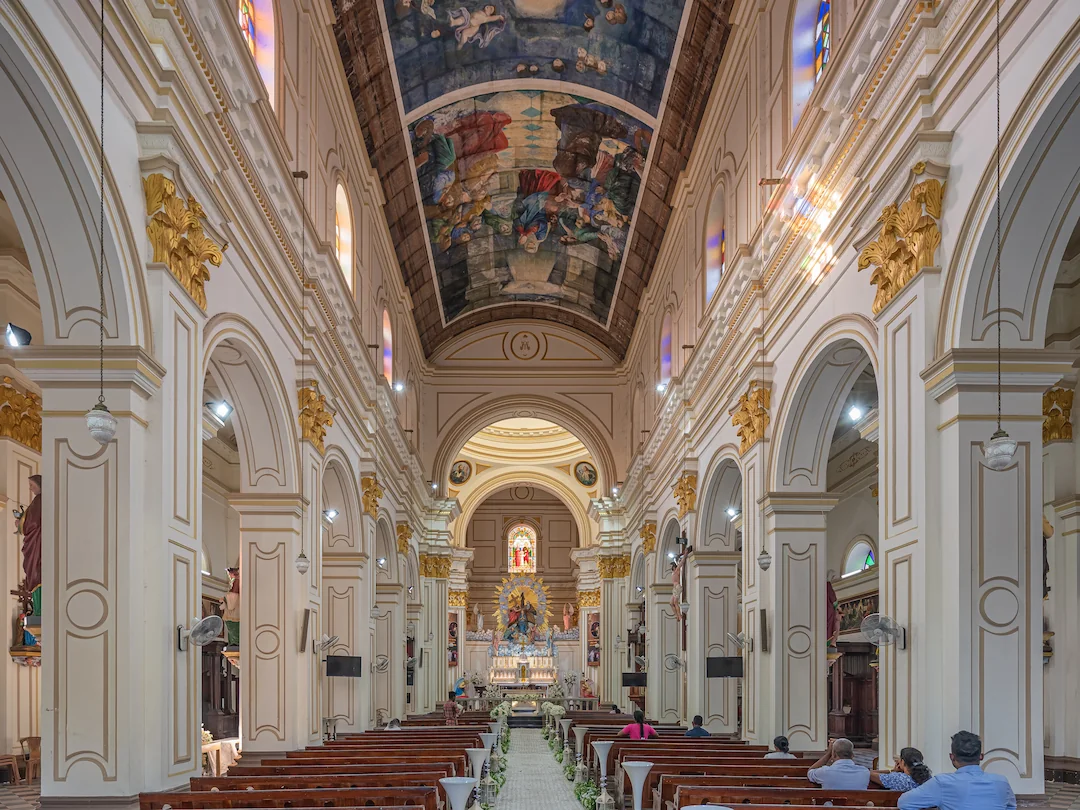Negombo is a city that wears its history proudly, with traces of colonial influence, centuries-old fishing traditions, and a multicultural population that make it truly one-of-a-kind. Whether you’re intrigued by the long stretches of sandy beaches or fascinated by its role in the global spice trade, Negombo offers an experience where past and present coexist seamlessly.
Negombo Overview
Negombo is one of Sri Lanka’s major cities, but there’s more to it than its geographical significance. Located at the mouth of the Negombo Lagoon, it’s only about 38 kilometers (24 miles) from Colombo, which makes it easy to reach via the Colombo–Katunayake Expressway.
It’s a short 9-kilometer drive from the Bandaranaike International Airport, making it the nearest significant city to the country’s main air travel hub.
Beyond convenience, Negombo is a bustling commercial hub, particularly for those involved in Sri Lanka’s fishing industry.
With a population of about 142,136, Negombo isn’t just about numbers—it’s about the people and the cultural mix they represent. The city has a distinct bilingual population, with both Sinhala and Tamil commonly spoken. However, what stands out most is its strong Roman Catholic presence, a legacy left behind by the Portuguese colonizers. This has earned the city the nickname “Little Rome” due to its abundance of churches and Catholic followers.
Origins of the Name “Negombo”
Like many places with rich histories, Negombo has an interesting story behind its name. “Negombo” is a remnant of its colonial past, specifically a Portuguese twist on the original Tamil name “Neerkolombu.” It’s fascinating to think that even a city’s name can reflect centuries of cultural exchange.
On the Sinhala side of things, Negombo is known as “Migamuva.” This name, intriguingly, has roots in ancient Tamil naval terminology, with “meegaman” referring to a naval captain. This gives us a glimpse into how much the sea and seafaring shaped the identity of the city, long before colonial powers took an interest in it.
Now, if you dig a little deeper into local folklore, a beautiful tale links Negombo’s Sinhala name, “Mee-Gomuwa,” to the idea of a “village of the honeycomb.” According to the Rajaveliya, a historical chronicle, King Kavantissa’s army found honey in a canoe near the seashore for Viharamahadevi, who was carrying the future King Dutugamunu at the time. Because of this event, the place earned the name Mee-Gomuwa, showing that even legends weave into the fabric of this fascinating city.
Historical Significance
Pre-Colonial Era: A Hub of Trade and Culture
Negombo’s story stretches far beyond colonialism. Before the Portuguese arrived, the city was already thriving under the rule of the Sinhala monarchy based in Sri Jayawardanapura Kotte. What’s striking is that even before foreign invaders set their sights on it, Negombo had become a vital point for trade, particularly for cinnamon a spice that the world couldn’t get enough of.
Interestingly, Negombo also served as a safe harbor for Arabic vessels. Many of the descendants of these Arab traders are now known as the Sri Lankan Moors, an ethnic group that continues to call Negombo home. So, Negombo wasn’t just a stop on a map; it was a cultural and commercial crossroads that played a key role in Sri Lanka’s global connections.
Portuguese Ceylon: The Rise of Catholicism
When the Portuguese arrived in the early 1500s, they changed the course of Negombo’s history in ways that are still visible today. After overthrowing the Sinhala monarchy, the Portuguese quickly built a fort in Negombo, making it a strategic point for their control over the cinnamon trade. But they didn’t stop there. One of their most lasting impacts was religious: the mass conversion of the local Karava community who had been predominantly Buddhist and Hindu—to Catholicism. Today, nearly two-thirds of Negombo’s population is Catholic, a legacy that’s earned the city the nickname “Little Rome.” The town’s skyline is still dotted with churches, a testament to this era of change.
Dutch Ceylon: Conflict and Trade Decline
In 1646, the Dutch took over Negombo from the Portuguese, and for a time, it seemed like they would control the cinnamon trade just as the Portuguese had. But it wasn’t that simple. The Kingdom of Kandy, which had its own political agendas, didn’t make things easy for the Dutch. The King of Kandy stirred conflict between the Dutch and Portuguese and, at one point, even captured Negombo Fort.
Despite the Dutch regaining control, their troubles didn’t end there. Throughout the 18th century, the demand for cinnamon skyrocketed, but supply couldn’t keep up, leading to a significant drop in cinnamon exports between 1785 and 1791.
Still, the Dutch left their mark on Negombo in ways that extend beyond trade. Their colonial architecture, including the fort they built in 1672, still stands today. Additionally, the canal system they developed, which stretches 120 kilometers from Colombo to Puttalam, is a reminder of their influence on the region’s infrastructure.
British Ceylon: The Decline of the Cinnamon Industry
By the time the British arrived in 1796, the once-thriving cinnamon industry had already begun to decline. British commander Colonel Stuart took over the trade, but it was clear that the industry was on its last legs. Poor policies, especially those enacted by Frederick North, the first Governor of British Ceylon, only worsened the situation.
However, while cinnamon was no longer the moneymaker it had been, Negombo didn’t fade into obscurity.
After the British captured the Kingdom of Kandy in 1815, Negombo’s strategic value may have diminished, but its commercial importance remained strong. The Negombo fishery became a key player in the island’s seafood trade, drawing migrant fishermen from various parts of Sri Lanka. The arrival of the British railway system in 1907 further encouraged commercial growth, particularly in coconut, tea, and coffee plantations, helping the city develop into a prosperous trading center.
Colonial Architecture in Negombo
Negombo, a coastal city in Sri Lanka, is rich with colonial architecture, a legacy left behind by the Portuguese, Dutch, and British, who successively controlled the region. Each colonizer influenced the architectural landscape of the city, leaving behind a variety of structures that showcase their styles and purposes.
- Dutch Fort (1644)

The Dutch Fort in Negombo, originally built by the Portuguese in the early 17th century, was captured and fortified by the Dutch in 1644. It was strategically located near the lagoon to oversee maritime activity. The fort initially served as a military outpost and later a prison. Today, only the ruins of the entrance and parts of the walls remain, as much of it was demolished by the British in the early 19th century. The Dutch influence can be seen in the fort’s thick walls, which were built using coral and limestone, which are characteristic of Dutch military architecture during this era. The fort’s remnants are a reminder of Negombo’s significance during Dutch rule.
- Dutch Canal (1658-1796)
The Dutch Canal, also known as the Hamilton Canal, is an intricate network of waterways stretching from Colombo to Puttalam, passing through Negombo. Built by the Dutch in the late 17th century, this canal system was designed primarily for transporting goods, particularly cinnamon, which was a valuable export during the colonial period.
The canal remains functional and is a prominent feature of Negombo’s landscape. The Dutch mastery of hydraulic engineering is evident in the canal’s construction, which helped control floods and enhance trade routes in the region.
- St. Mary’s Church (1874)

A prime example of British colonial architecture in Negombo is St. Mary’s Church, a grand Catholic church constructed between 1874 and 1922. It stands as one of the largest cathedrals in Sri Lanka, reflecting the colonial emphasis on religious institutions.
The church’s architecture is a blend of Neo-Baroque and Victorian styles, with towering columns, vaulted ceilings, and intricate frescoes inside. The British influence is seen in its symmetrical design and use of imported materials. Its location in the heart of Negombo symbolizes the importance of religion in the colonial administration’s social structure.
- The Grand Street Building
Another important colonial structure is the Grand Street Building, which served as a municipal office during the British period. Built in the late 19th century, the building showcases typical British colonial architecture with high ceilings, large verandas, and a central courtyard.
It features a combination of brick and wood, with ornamental columns and wrought iron railings. Although now used for different administrative purposes, the building’s original structure has been preserved, serving as a reminder of the British colonial administration in Negombo.
- Negombo Fish Market (1880s)
Though not as grand, the Negombo Fish Market, established in the late 19th century during British rule, is an important part of the city’s colonial history. The simple yet functional architecture reflects the British utilitarian approach to public buildings. The structure was designed to be open and airy, facilitating the local fish trade, which was the backbone of the economy in this coastal town.
- Negombo Post Office (1901)
The Negombo Post Office, constructed at the beginning of the 20th century, is another prominent example of British colonial architecture. This building, with its red brick façade and arched windows, embodies the Edwardian style, which was popular in British colonies at the time.
The post office played a crucial role in connecting the people of Negombo with the rest of the country and the world, symbolizing the growing importance of communication in the colonial administration.
Colonial architecture in Negombo not only reflects the aesthetic preferences of its former rulers but also demonstrates their functional approaches to governance, trade, and religion. From the Dutch military outposts to the British civic buildings, each structure tells a story of how colonial powers left a lasting imprint on the city’s urban landscape.
